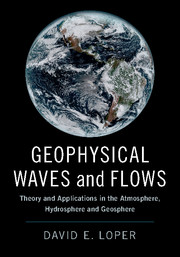Book contents
- Frontmatter
- Contents
- Preface
- Part I Introductory Material
- Part II Kinematics, Dynamics and Rheology
- Part III Waves in Non-Rotating Fluids
- Part IV Waves in Rotating Fluids
- Part V Non-Rotating Flows
- Part VI Flows in Rotating Fluids
- Part VII Silicate Flows
- 29 Equations Governing Silicate Flows
- 30 Cooling the Earth
- 31 Cooling the Mantle
- 32 Cooling the Core
- 33 Overview of Volcanic Flows
- 34 Flow in Volcanic Conduits
- 35 Lava Flows
- Part VIII Fundaments
32 - Cooling the Core
from Part VII - Silicate Flows
Published online by Cambridge University Press: 26 October 2017
- Frontmatter
- Contents
- Preface
- Part I Introductory Material
- Part II Kinematics, Dynamics and Rheology
- Part III Waves in Non-Rotating Fluids
- Part IV Waves in Rotating Fluids
- Part V Non-Rotating Flows
- Part VI Flows in Rotating Fluids
- Part VII Silicate Flows
- 29 Equations Governing Silicate Flows
- 30 Cooling the Earth
- 31 Cooling the Mantle
- 32 Cooling the Core
- 33 Overview of Volcanic Flows
- 34 Flow in Volcanic Conduits
- 35 Lava Flows
- Part VIII Fundaments
Summary
In this chapter we investigate the flows within the mantle that convey heat from Earth's metallic core upward to the surface. Heat is drawn out of the core by a thermal boundary layer (the D ̋ layer) at the base of the mantle, having a temperature contrast of roughly 800 K (see Figure 7.3). The large change in temperature within the D ̋ layer alters the properties of seismic waves and is believed to be the primary cause of subtle seismic anomalies at the base of the mantle. Also, this large temperature increase causes a large decrease in viscosity (by as much as a factor of 1000; see § 6.2.4), making this layer very mobile compared with the adjacent mantle material. This mobility permits hot material within the D ̋ layer to migrate horizontally to the base of a set of plumes, where it feeds upward flow within the plumes, which act as chimneys to convey this hot material to the surface. Flow within the D ̋ layer is investigated in § 32.1 and plume flow is studied in § 32.2.
D̋ Layer
The D̋ layer is both a thermal and dynamic feature of the lower-most mantle. It draws heat from the core via thermal conduction and advects heated mantle material toward the bases of plumes. This layer is maintained in a steady state with thermal diffusive thickening being balanced by a slow downward flow of mantle material into the layer to replace the heated material that is advected away. Since the viscosity of mantle material decreases strongly with temperature, the D ̋ layer has a double-layer structure, with the temperature adjusting across a thicker outer layer (roughly 150 km depth) and the viscosity and velocity adjusting in a thinner inner layer (roughly 20 km depth). In the following these two scales will be denoted by h with a suitable subscript: η for viscosity and T for temperature. In addition, we will encounter a third vertical scale, representing the temperature gradient at the core–mantle boundary.
Information
- Type
- Chapter
- Information
- Geophysical Waves and FlowsTheory and Applications in the Atmosphere, Hydrosphere and Geosphere, pp. 339 - 353Publisher: Cambridge University PressPrint publication year: 2017
